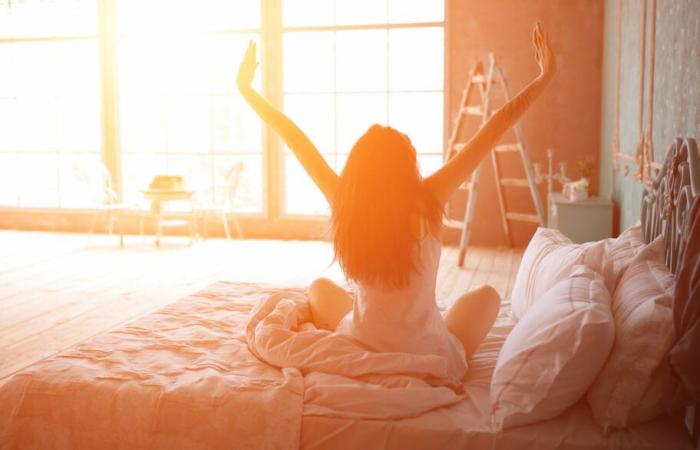For adults, doctors recommend an average sleep duration of between 7 and 9 hours. However, in France, we struggle to reach the lower end of this range. What can we do to try to improve our nights? Let’s take stock of some recent scientific results.
We are sleeping less and less. The annual survey of the National Institute of Sleep and Vigilance1 reveals that in 2024, the French say they sleep an average of 6 hours 42 minutes during the week and 7 hours 25 minutes on weekends, or 15 minutes less per day than in 2023. This downward trend, although it has accelerated in recent years, is not recent: we have lost 1 hour 30 minutes of daily sleep over the past 50 years. However, the same survey indicates that we are aware that adopting a healthy lifestyle contributes to better quality sleep. And in fact, correcting one’s habits is the first measure recommended by doctors and medical associations for the management of sleep disorders; before considering any drug treatment.
To understand the impact of lifestyle on our nights, let’s first delve into the biological mechanisms that govern sleep. Two elements regulate its duration, schedule and quality: sleep pressure and the biological clock. The first involves so-called homeostatic processes, which function like an hourglass that we turn over when we wake up. Adenosine plays a central role here: produced during the waking phases, this product of the degradation of ATP (the main source of energy for cells) accumulates throughout the day until it reduces neuronal excitability and causes us to fall asleep.
Our body also has a central clock located in the hypothalamus, directly connected to sleep structures. Thanks to it, the pineal gland (an endocrine gland shaped like a pine cone – hence its name – and located in the heart of the brain, which plays a central role in regulating biological rhythms) secretes melatonin – also called the “sleep hormone” – at the end of the day, when the light fades, which promotes falling asleep. During the waking phases, the same clock inhibits the production of melatonin and pushes the adrenal glands to secrete a hormone with opposite effects, cortisol. It stimulates gluconeogenesis in order to maintain blood glucose levels and provide energy to cells. Like a true conductor, our internal clock will also regulate body temperature and synchronize multiple peripheral clocks governing various biological functions such as appetite rhythms or intestinal contractions. The central clock itself is constantly reset to the day/night cycle by external synchronizers: mainly light, but also (with more modest influences) physical activity, meal times, social interactions or the outside temperature.
Our biological clock thus defines sleep windows where it will be of better quality. To strengthen it, it is therefore essential to observe good regularity in bedtime and waking hours and to listen to the first signs of falling asleep. But other strategies can also be put in place.
#1 Monitor your exposure time to light
Doctors recommend exposing yourself to the “blue of the sky” from the morning, in order to stimulate the production of cortisol and inhibit that of melatonin. Synchronization by light actually involves the activation of photoreceptors present in our retina, the melanopsin cells, which are more specifically sensitive to blue light. Contemplating the clouds through the window of your office or apartment will not be enough. Indeed, the brightness rarely exceeds a few hundred lux, when the standard recommendations are 10,000 lux (the equivalent of the illumination of a surface in the shade in summer) for at least half an hour. Conversely, and still to promote the good synchronicity of our clock, it is very important to dim the lights and not look at screens in the evening (studies suggest durations ranging from 30 minutes to 2 hours before bedtime), because they diffuse a light rich in blue.
A recent study conducted by Inserm, the results of which are published in the Journal of Pineal Research, has refined these recommendations.2. Using two separate groups of volunteers, with an average age of 25 and 59, she looked at the production of melatonin after exposure to different colors. It appears that while melanopsin is the only photoreceptor involved in inhibiting the production of the hormone in young subjects, in older subjects, other photoreceptors, sensitive to different colors, also come into play. This mechanism would be an adaptation to the browning of the lens occurring with age, which would reduce the amount of light reaching the retina. These results therefore suggest that older people would particularly benefit from exposing themselves daily to daylight, which is richer in wavelengths than artificial light. The researchers also recommend, if going out is impractical, adapting the color and brightness of indoor lighting.
#2 Exercise
The scientific literature is full of consistent evidence of a positive association between physical activity and better sleep. Two studies published in 2024, one by Reykjavik University3the other by the University of South Australia complete this bibliography4. In the Icelandic study, 4,339 participants from 9 European countries aged 39 to 67 were followed for a period of 10 years. Physical activity levels, duration and sleep disorders were assessed by questionnaires. Conclusion: people who maintained regular physical activity during the study period reported fewer difficulties falling asleep or extreme sleep durations (less than 6 hours or more than 9 hours) than the most sedentary subjects. The Australian study, which was based on an assessment of the activity parameters of a population of 1,168 children and 1,360 adults, for 8 days and 24/24, shows that moderate to vigorous physical activity during the day is correlated with longer and better quality sleep. Researchers believe this effect may be due to increased secretion of serotonin, which promotes both mood improvement and melatonin production.
Other studies also suggest respecting, as far as possible, regular practice times, avoiding those before bedtime. A study conducted by the University of Caen-Normandy published in 20245 could qualify this recommendation. Conducted on 16 healthy young adults, it suggests that moderate physical activity of 30 minutes, one hour before bedtime, has, in this population at least, only a very minimal impact on sleep efficiency. But further research will be necessary to confirm these results.
#3 Take care of your dinner
It is commonly accepted that it is good to avoid caffeinated drinks in the evening. Why? Because caffeine binds to the same receptors as adenosine, delaying the feeling of fatigue. As for the contents of your plate, a study conducted by the team led by Armelle Rancillac, a researcher at Inserm and the Collège de France, shows that a dinner rich in glucose promotes sleep6. The researcher is interested in glial cells, cells that are more numerous than neurons and essential to their functioning. Her work more specifically concerns astrocytes, named for their star shape. Her research has shown that these cells, which capture blood glucose, are capable of inducing a variable release of adenosine depending on the time of day. Astrocytes take the time into account to adapt their response to the same increase in glucose. This response is therefore greater in the evening than in the morning, in order to promote sleep at the end of the day.
Anne Orliac
12024 annual survey by INVS / Fondation VINCI Autoroutes conducted by Opinion Way: https://institut-sommeil-vigilance.org/mange r-bouger-dormir-trouver-l e-bon-rythme-e nquete-insv-fondation-vin ci-autoroutes-pour-la-jou rnee-du-sommeil-2024/↑
2Najjar RP, Prayag AS, Gronfier C. Melatonin suppression by light involves different retinal photoreceptors in young and older adults. J Pineal Res. 2023;e12930. doi:10.1111/jpi.12930↑
3Bjornsdottir E, Thorarinsdottir EH, Lindberg E, et al. Association between physical activity over a 10-year period and current insomnia symptoms, sleep duration and daytime sleepiness: a European population-based study. BMJ Open 2024;14:e067197. doi:10.1136/bmjopen-2022–067197↑
4Matricciani L, Dumuid D, Stanford T, Maher C, Bennett P, Bobrovskaya L, Murphy A, Olds T. Time use and dimensions of healthy sleep: A cross-sectional study of Australian children and adults. Sleep Health. 2024 Jun;10(3):348–355. doi: 10.1016/j.sleh.2023.10.012. Epub 2024 Jan 9. PMID: 38199899↑
5Perrier J, Langeard A, Ouma CK, Sesboüé B, Clochon P, Prevost J‑N, Bertran F, Davenne D and Bessot N (2024) Effects of acute bouts of evening resistance or endurance exercises on sleep EEG and salivary cortisol. Forehead. Physiol. 15:1313545. doi: 10.3389/fphys.2024.1313545↑
6Scharbarg, E., Daenens, M., Lemaître, F. et al. Astrocyte-derived adenosine is central to the hypnogenic effect of glucose. Sci Rep 6, 19107 (2016). https://doi.org/10.1038/srep19107↑






